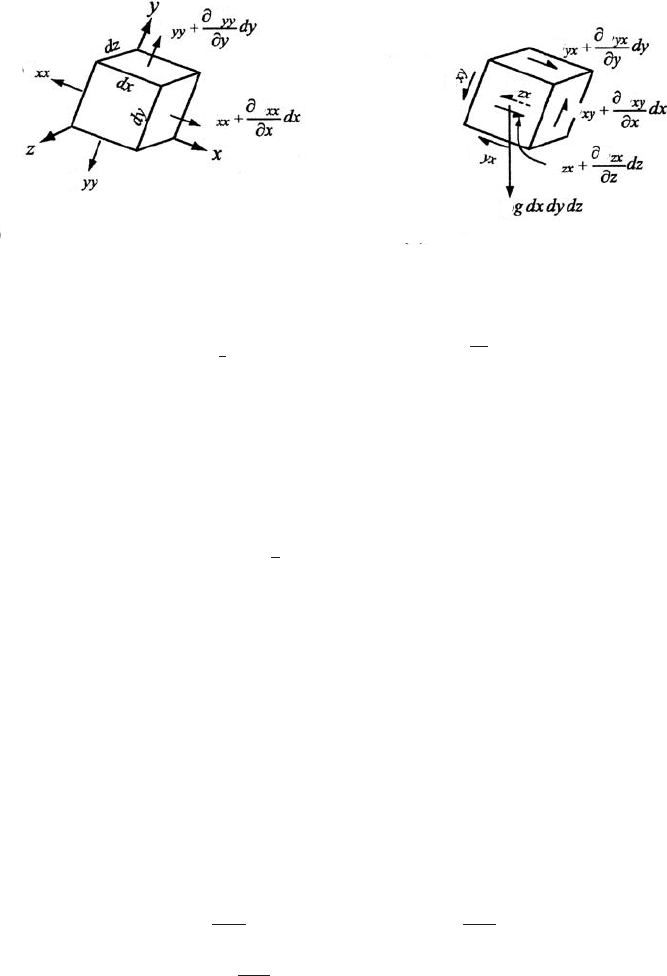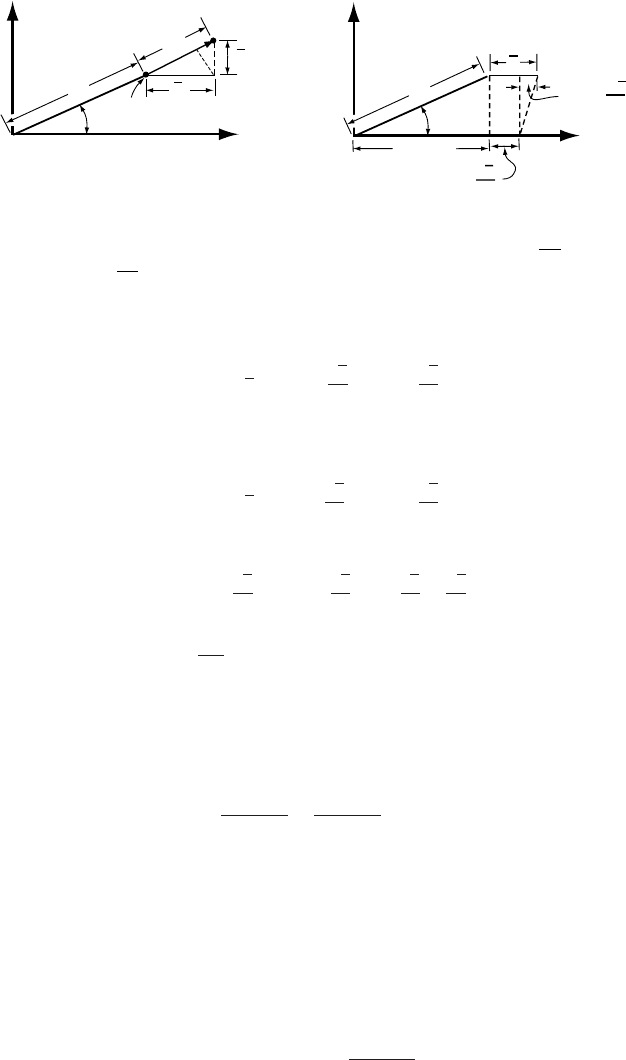Hooke R.L. Principles of glacier mechanics
Подождите немного. Документ загружается.


Momentum balance 261
s
s
s
s
s
s
s
s
r
s
s
s
s
s
s
s
(
a
) (
b
)
Figure 9.5. Stresses on a block of size dx dy dz. (a) Normal stresses. (b) Shear
stresses (in the x-direction only).
from Equation (9.14) that
1
2
[(σ
xx
− σ
yy
)
2
+ 4σ
2
xy
]
1/2
=
√
J
2
= σ
e
.So
the invariants we first identified in Equations (9.5) in two dimensions are
functions of I
1
and J
2
.
The right-hand side of Equation (9.14) turns out to be the maximum
shear stress in plane strain. You can show this by setting the derivative
of Equation (9.2) equal to 0. If the axes were, in addition, chosen to be
parallel to the principal stresses, σ
xy
would vanish, leaving:
σ
e
=±
1
2
(σ
1
− σ
2
)
The directions of the maximum shear stresses would then be 45
◦
and
135
◦
to the principal axes. (To show this, determine the orientation of
the planes on which σ
S
is a maximum, using a procedure similar to that
which we used to obtain Equations (9.3), and compare these planes with
the orientations of the planes on which σ
N
is a maximum.)
Momentum balance
The stress equilibrium equations are derived by balancing forces in the
directions of the coordinate axes. Consider forces in the x-direction on
ablock of size dx dy dz as shown in Figure 9.5:
F
x
=−σ
xx
dy dz+
σ
xx
+
∂σ
xx
∂x
dx
dy dz −σ
yx
dx dz+
σ
yx
+
∂σ
yx
∂y
dy
dx dz
−σ
zx
dx dy +
σ
zx
+
∂σ
zx
∂z
dz
dx dy + ρg
x
dx dy dz = 0
The first two terms on the right are the normal forces on the faces of
the block that are normal to the x-axis. Note that in each case, the stress
(shown in Figure 9.5)ismultiplied by the area of the face, in this case

262 Stress and deformation
dy dz,toobtain a force. The next four terms are the shear forces in the
x-direction on faces normal to the y- and z-axes, respectively. The last
term is the body force; g
x
in this term represents the component of the
gravitational acceleration that is parallel to the x-axis. Canceling like
terms of opposite sign and dividing by dx dy dz yields:
∂σ
xx
∂x
+
∂σ
yx
∂y
+
∂σ
zx
∂z
+ ρg
x
= 0
Similar expressions are readily obtained in the y- and z-directions. Using
the summation convention, these become:
∂σ
ij
∂x
i
+ ρg
j
= 0 (9.15)
As i is repeated in the first term, this represents three terms. However,
j is not repeated, so we can write separate equations for j = x, y, and z.
Thus Equation (9.15) represents three equations.
Because F = ma = m(dv/dt) = (d/dt)(mv)where m is mass, a
is acceleration, v is velocity, and mv is momentum, Equations (9.15)
represent conservation (e.g. d/dt = 0) of linear momentum.
Deformation
Having applied a stress to a medium, we expect strain or deformation to
occur. Suppose
x, y, and z (Figure 9.6) represent the displacement of a
particle from P to P
in the directions of the coordinate axes, respectively.
We will consider infinitesimal displacements so the time required for the
deformation → 0.
P
P'
x
z
y
Figure 9.6. Components
of a displacement from P to
P
.
Normal strain in the x-direction at P is defined as:
ε
xx
= Lim
→0
(9.16)
where is the length of a line drawn in the x-direction, and is the
elongation of that line, so / is the elongation of the line per unit
length. Referring to Figure 9.7,ifaline, initially of length ,istranslated
such that its left end moves a distance
x in the x-direction, its right end
moves a distance
x + (∂x/∂ x)inthis direction, and the x-component of
its new length is + , then substituting into Equation (9.16) yields:
ε
xx
= Lim
→0
x +(∂x/∂ x) − x
=
∂
x
∂x
(9.17)
By taking the limit as →0weeliminate the variation with x, thus obtain-
ing ε
xx
at point P. Similarly: ε
yy
= ∂y/∂ y and ε
zz
= ∂z/∂z.
+ ∆
x
x +
∂
x
∂ x
Figure 9.7. Elongation of
a line during deformation.

Deformation 263
y
x
x
y
∂
x
∂ y
∂
y
∂ x
Figure 9.8. Change in a
right angle during
deformation.
Shear strain is defined as one half the decrease in an initially right
angle. Referring to Figure 9.8, this can be expressed as:
ε
xy
=
θ
2
=
1
2
Lim
→0
tan
−1
(∂x/∂ y)
+ tan
−1
(∂y/∂ x)
For infinitesimal changes, θ ≈ tan θ so:
ε
xy
=
1
2
∂
x
∂y
+
∂
y
∂x
(9.18a)
and similarly
ε
yz
=
1
2
∂
z
∂y
+
∂
y
∂z
(9.18b)
and
ε
zx
=
1
2
∂
x
∂z
+
∂
z
∂x
(9.18c)
As before (Chapter 2), there are nine components of strain. Thus, this
is another second rank tensor, the strain tensor. It, too, is symmetric
because ε
xy
= ε
yx
and so forth.
In general, shear results in rotation as well as distortion. For example,
if ∂
x/∂y = ∂y/∂x in Figure 9.8, the dotted line inclined at 45
◦
to the
x-axis will be rotated through an angle:
ω
xy
=
1
2
∂
x
∂y
−
∂
y
∂x
Similar expressions may be written for other rotations.
To obtain rates, which are normally of greater interest in a deforming
ice mass, we differentiate with respect to time. Thus, the normal strain
rate in the x-direction, ˙ε
xx
, is:
˙ε
xx
=
dε
xx
dt
=
d
dt
∂
x
∂x

264 Stress and deformation
Velocity is defined as a change in distance with time, or if u is the velocity
in the x-direction, u = d
x/dt. Thus, we obtain:
˙ε
xx
=
∂u
∂x
(9.19)
Similarly, shear strain rates become:
˙ε
xy
=
1
2
∂u
∂y
+
∂v
∂x
(9.20)
and so forth.
The symmetry of Equation (9.20) suggests the possibility of again
using the summation convention to write expressions for the strain rates,
thus:
˙ε
ij
=
1
2
∂u
i
∂x
j
+
∂u
j
∂x
i
(9.21)
If i =j in this expression, it reduces to Equation (9.19), so this formulation
represents both shear and normal strain rates.
Similarly, the rotation rate tensor is:
˙ω
ij
=
1
2
∂u
i
∂x
j
−
∂u
j
∂x
i
(9.22)
The rotation rate tensor is antisymmetric because ˙ω
ij
=−˙ω
ji
. Note also
that ˙ω
ij
= 0when i = j.Inother words, pure stretching does not result in
rotation. If ˙ω
ij
= 0 for all i, j the flow is said to be irrotational. Rotations
do not change the size or shape of an element, so they do not require the
application of a stress.
As implied by the notation ∂u
i
/∂x
j
(i, j =x, y, z), the velocity vector
has three components, and each of them can vary in each of the three
coordinate directions. Thus there are nine velocity derivatives.
∂u
∂x
∂u
∂y
∂u
∂z
∂v
∂x
∂v
∂y
∂v
∂z
∂w
∂x
∂w
∂y
∂w
∂z
This is sometimes called the velocity derivative tensor. The velocity
derivative tensor is not symmetric, as ∂u
i
/∂x
j
= ∂u
j
/∂x
i
in general.
Therefore, it can be decomposed into symmetric and antisymmetric
parts. The symmetric part is represented by Equation (9.21), and the
anti-symmetric part by Equation (9.22).

Deformation 265
Logarithmic strain
In Equation (9.16)wedefined strain by:
ε = Lim
→0
where is the initial length of a line and is the elongation of that line.
This definition is suitable for small (infinitesimal) strains. However, when
calculating strains or strain rates from measurements, the total strain is
normally not infinitesimal. This is, in part, because deformations must
be large enough to exceed the uncertainty in the measurement method.
If strains are infinitesimal, we can replace with d. The total
strain is then the sum of the infinitesimal strains, or:
ε =
=
1
=
o
d
=
1
o
d
where
o
is the initial length of the line and
1
is its final length. Integrating
yields:
ε = ln
1
o
(9.23)
or in terms of rates:
˙ε =
1
t
ln
1
o
(9.24)
where t is the time interval between measurements. This is known as
logarithmic strain.
General equations for transformation of strain
in two dimensions
Our next objective is to develop an expression for the strain rate in an
arbitrary direction, θ .Tosimplify the equations, we restrict the analysis to
the case of plane strain. We will then take the derivative of this expression
and set it equal to zero to find the directions in which ˙ε(θ)ismaximum
and minimum (the principal strain rates). Finally we will look at the
implications of this in terms of the flow law.
Let us examine the elongation of line
OP in Figure 9.9a. The line
has an initial length and makes an angle θ with the x-axis. The line is
stretched to a final length
OP
through a displacement with components
x and y in the x- and y-directions, respectively. The elongation is given
by (Figure 9.9a):
= x cos θ + y sin θ (9.25)
The displacement x is a consequence of strain parallel to the x-axis and
a shear strain which results in tilting of any line that is initially normal

266 Stress and deformation
y
x
x
y
o
P
P'
q
∆
y
x
q
sin
q
cos q
cos q
∂
x
∂ x
sin
q
∂
x
∂
y
(a) (b)
x
Figure 9.9. (a) Components of strain of a line of initial length = OP and final
length
OP, and (b) details of the shear component of the strain.
to the x-axis (Figure 9.9b), thus:
x = cos θ
∂
x
∂x
+ sin θ
∂
x
∂y
(9.26a)
The origin of the two terms on the right-hand side may be clarified by
reference to Figures 9.7 and 9.8, respectively. Similarly:
y = sin θ
∂
y
∂y
+ cos θ
∂
y
∂x
(9.26b)
Substituting Equations (9.26) into Equation (9.25) yields:
= cos
2
θ
∂
x
∂x
+ sin
2
θ
∂
y
∂y
+
∂
x
∂y
+
∂
y
∂x
cos θ sin θ
Finally, dividing by ; noting that Lim
→0
(/) =ε(θ ), the strain along
the length of line
OP; and using Equations (9.17) and (9.18a)toexpress
the derivatives in terms of strains yields:
ε(θ) = ε
xx
cos
2
θ + ε
yy
sin
2
θ + 2ε
xy
cos θ sin θ
With the trigonometric identities used earlier (p. 254), this becomes:
ε(θ) =
ε
xx
+ ε
yy
2
+
ε
xx
− ε
yy
2
cos 2θ + ε
xy
sin 2θ (9.27)
Strain rates can be obtained by taking the derivative with respect to time.
Equation (9.27)isauseful relation for obtaining normal strains or strain
rates in an arbitrary direction, θ,when values in the coordinate directions
x, y are known.
To obtain the maximum and minimum values of ε(θ ), the principal
strain rates, we proceed as before (Equations (9.3)) to take the derivative
with respect to θ, set it to zero, and solve for θ, thus:
tan 2θ
sr
=
2˙ε
xy
˙ε
xx
− ˙ε
yy
(9.28)

Condition that principal axes coinside 267
The two solutions for θ are the directions in which the strain rate is a
maximum and minimum. The magnitudes of the principal strain rates
can be obtained as we did for the principal stresses (Equation (9.4)).
Condition that principal axes of stress and strain
rate coincide
In calculating the stress and velocity fields in a glacier in Chapter 10,
we will need to assume that the principal axes of stress and strain rate
coincide. Let us explore the consequences of this condition.
We found earlier (Equation (9.3b)) that the angle which the principal
stresses make with the x-coordinate may be obtained from:
tan 2θ
stress
=
2σ
xy
σ
xx
− σ
yy
=
2σ
xy
σ
xx
− σ
yy
Note that it does not matter whether we use deviatoric or total stresses
here, as σ
xy
= σ
xy
and σ
xx
− σ
yy
= σ
xx
− P − (σ
yy
− P) = σ
xx
− σ
yy
.
The condition that the principal axes of stress and strain rate coincide
is θ
stress
= θ
sr
,oratany given point in the medium:
2σ
xy
σ
xx
− σ
yy
=
2˙ε
xy
˙ε
xx
− ˙ε
yy
The only way to satisfy this condition in the general case is to let:
˙ε
xy
= λσ
xy
;˙ε
xx
= λσ
xx
;˙ε
yy
= λσ
yy
where λ is a scalar; that is, its value at the particular point in the medium
is independent of the direction in which the stress is acting. However, λ
may vary from one point to another in the medium, so λ = λ(x, y, z).
The fact that λ is a scalar implies that the deforming material is
isotropic and incompressible. Thus, under a given stress, it will deform
at the same rate regardless of the direction in which the stress is applied.
Obviously, this is an approximation in a material such as ice that first has
an hexagonal crystal structure, and secondly can develop a fabric with a
preferred orientation. [If the material were compressible, a compressive
deviatoric stress in, say, the x-direction, σ
xx
,would cause more defor-
mation than the corresponding tensile deviatoric stress in the y-direction
(which must equal σ
xx
in magnitude in plane strain). Thus, λ would differ
between the two directions.]
We generalize this assumption to three dimensions and formalize it
by writing:
˙ε
ij
= λσ
ij
(9.29)

268 Stress and deformation
remembering that
˙ε
ij
=
1
2
∂u
i
∂x
j
+
∂u
j
∂x
i
(9.30)
and
σ
ij
= σ
ij
−
1
3
ij
σ
kk
Because the stress and strain rate in the flow law are defined in terms
of either the effective or the octahedral stress and strain rate, we can write
out the first few terms of the effective strain rate and substitute Equation
(9.29) into the right-hand side, as follows:
˙ε
2
e
=
1
2
˙ε
2
xx
+ ˙ε
2
xy
+ ˙ε
2
xz
+ ···
=
1
2
λ
2
σ
2
xx
+ λ
2
σ
2
xy
+ λ
2
σ
2
xz
+ ···
=
λ
2
2
σ
2
xx
+ σ
2
xy
+ σ
2
xz
+ ···
= λ
2
σ
2
e
Dropping the subscript e for convenience (and also because the flow law
can be written in terms of either the effective or the octahedral stress and
strain rate), we obtain:
˙ε = λσ = f (σ )soλ =
f (σ )
σ
(9.31)
Here, f (σ )isused to emphasize that in the general case, λ is a function
of the applied stress.
Afew examples will serve to illustrate the meaning of λ.
r
Newtonian fluid: λ = 1/η,where η is the Newtonian viscosity so in
this case λ is not a function of σ (see Equation (2.17)).
r
Power-law fluid: λ = σ
n−1
/B
n
,so˙ε = λσ =
(
σ/B
)
n
.
r
Perfectly plastic material: as noted earlier (Figure 9.4), in a per-
fectly plastic material there is no deformation below a critical stress,
σ = k,soλ = 0 for σ<k. When σ = k, the material deforms at a rate
such that the stress does not exceed k.Inother words, λ depends on
˙ε : λ = f
1
(˙ε).
In the case of the power-law fluid, λ varies with σ and B, and because
B is a function of temperature, density, crystal size and orientation, and
perhaps other factors, λ varies with these properties as well.
Combining Equations (9.29), (9.30), and (9.31), writing ˙ε in terms
of velocity derivatives, and using the summation convention, we now

Summary 269
have the following relation between individual components of the stress
and strain rate tensors:
1
2
∂u
i
∂x
j
+
∂u
j
∂x
i
=
f (σ )
σ
σ
ij
(9.32a)
This represents nine equations, only six of which are independent.
Together with Equation (9.15):
∂σ
ij
∂x
i
+ ρg
j
= 0 (9.32b)
which represents an additional three equations, we have nine independent
equations which can be solved for the three normal stresses, three shear
stresses, and three velocities. Our objective in Chapter 10 will be to do
this, but to simplify the problem, we will confine our attention to plane
strain.
Summary
In this chapter, we have reviewed some elementary principles of con-
tinuum mechanics with a particular focus on those principles needed
to understand much of the classical as well as the modern literature on
glacier flow.
In the first part of the chapter, we defined stress and showed that if
we know the stresses in one coordinate system, we can calculate them
in another system rotated with respect to the first. This allowed us to
calculate the direction and magnitude of the maximum and minimum
normal stresses, the principal stresses.Wedid the calculation in two
dimensions, but the extension to three dimensions is straightforward,
though tedious. We found that shear stresses vanish in coordinate systems
chosen with axes aligned parallel to the principal stresses.
The orientation and magnitude of the principal stresses is a property
of the stress field and not of the orientation of the axes. Thus, there
are certain combinations of the stresses that must be independent of the
orientation of the axes: the invariants of the stress tensor. Glen’s flow
law for ice is based on the second of these invariants. This is logical
because it is invariant, and also because the von Mises yield criterion
can be expressed in terms of this invariant. Recent experimental data
have validated this approach.
In the second part of the chapter, we derived the stress equilibrium
or momentum balance equations.
In the third part, we defined strain and derived equations for calcu-
lating strains or strain rates in coordinate systems rotated with respect
to one another. These equations are similar to those for transformation
270 Stress and deformation
of stress. As with stresses, we introduced the concept of principal strain
rates.
Finally, we showed that if a material is isotropic and incompressible,
the principal axes of stress and strain rate coincide. Ice is clearly not
isotropic and incompressible, but this approximation has proven to be a
convenient starting point for calculations of glacier flow.
